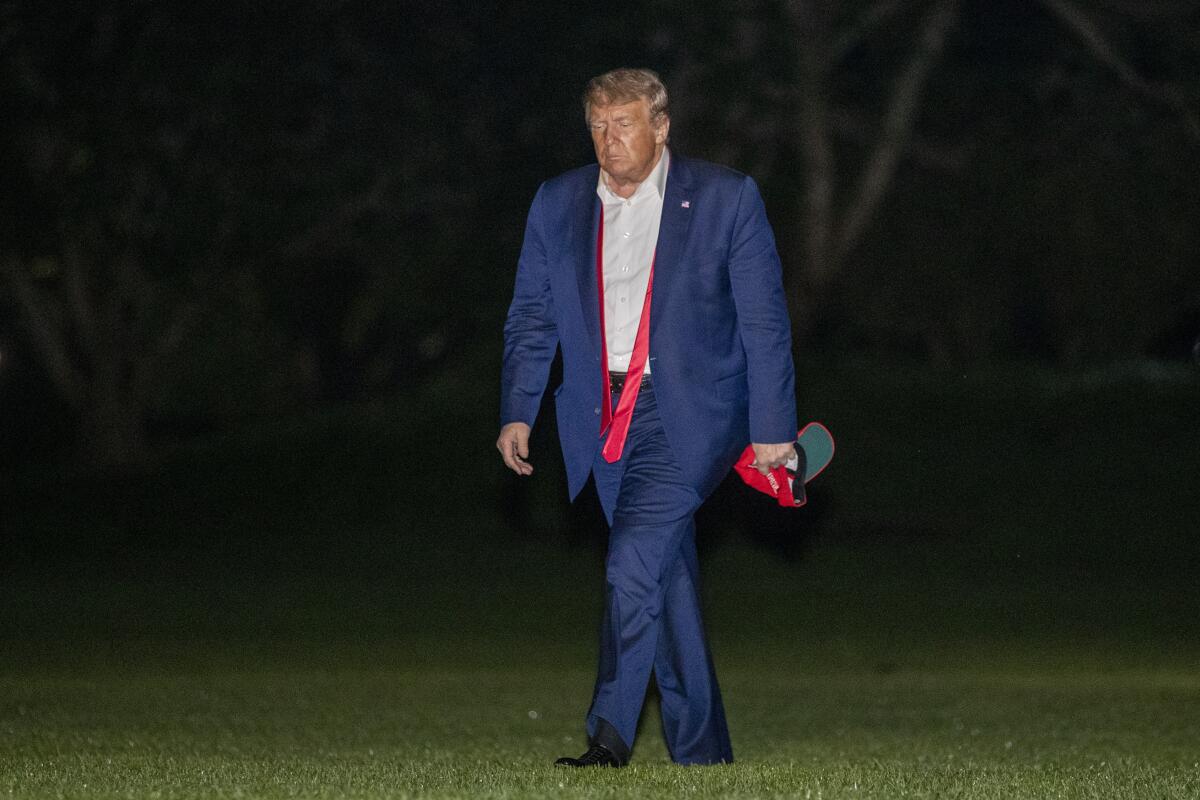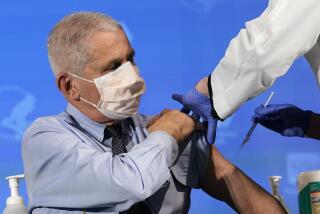COVID-19 surge in South, Southwest poses growing threat, experts warn

WASHINGTON — Infectious disease experts expressed alarm Sunday over the pace of new coronavirus infections in several states in the South and Southwest, with one likening the spread in parts of the country to a “forest fire.”
At the same time, President Trump’s surrogates insisted he was joking on Saturday when he told rally-goers he had ordered a testing slowdown because the results painted an overly dire picture of the pandemic.
With the United States now reporting a quarter of the world’s coronavirus cases, and daily new-infection counts exceeding 30,000 nationwide on at least two recent days, eight states — California among them — last week hit single-day new-case highs, according to figures compiled by Johns Hopkins University.
In California, much of the increase in the total number of cases does appear to be a result of more testing, health officials say. That does not fully explain the overall caseload increase in several other states, however, public health experts said, directly contradicting a major talking point by the president and some of his aides.
In some of the most affected states, such as Florida and Arizona, not only are larger proportions of tests coming back positive, but more of the afflicted are becoming sicker, Thomas Inglesby of Johns Hopkins’ School of Public Health said in an interview on “Fox News Sunday.”
“What we are seeing is increased positivity in testing, and in many cases increased hospitalization,” Inglesby said. “That’s not just because we’re doing more testing in a state; that’s because there is more serious disease in a state.”
Florida Gov. Ron DeSantis (R) conceded that point at a news conference on Saturday in Tallahassee, the state capital, saying that even with test rates flat or increasing, “the number of people testing positive is accelerating faster than that.”
Although death rates in the U.S. from COVID-19 have continued to decline after the peak hit in New York in April, the number of people hospitalized has climbed sharply in several states, and health officials fear that deaths could start rising again soon.
“This is going to be hard to get under control,” said Scott Gottlieb, commissioner of the Food and Drug Administration earlier in Trump’s tenure. “These are big states that have a lot of cases; they’ve been building.”
In addition to California, other states that recently have reported highs in single-day new infections include Florida, Arizona, Nevada, Oklahoma, South Carolina, Texas and Utah, according to Johns Hopkins’ coronavirus tracker. Several of those states were among the earliest to allow businesses to fully reopen.
Interviewed on CBS’ “Face the Nation,” Gottlieb said that while “we’re not going to want to shut down business again,” there were “not a lot of tools we can reach for” as the spread of the virus continues.
Trump has largely ignored the growing signs of an increase, focusing almost exclusively on pushing states to reopen. At his rally Saturday in Tulsa, held amid a spike of coronavirus cases in Oklahoma, he called testing for the virus “a double-edged sword,” adding: “When you do testing to that extent, you’re gonna find more people; you’re gonna find more cases.”
Trump has often suggested that more testing fuels an inflated sense of the seriousness of the crisis. But addressing the relatively thin rally crowd — the Tulsa Fire Department on Sunday put attendance at 6,200 in a 19,200-capacity stadium — he went further, saying: “So I said to my people, ‘Slow down the testing, please.’”
The president’s aides quickly declared he was making a humorous aside, a line they stuck with in television interviews Sunday.
Trade adviser Peter Navarro, appearing on CNN’s “State of the Union,” called Trump’s testing remark “tongue-in-cheek” and “a light moment.”
Pressed as to why Trump would make a jocular reference to a pandemic that has cost at least 120,000 American lives, he responded testily: “Asked and answered.”
Acting Homeland Security Secretary Chad Wolf said on ABC’s “This Week” that while many of Trump’s remarks on a variety of subjects stem from “a humor standpoint,” the rally comment also reflected “frustration” over media coverage of the coronavirus outbreak.
“All they want to focus on is an increasing test count — we know that’s going to occur when you’re testing more,” he said.
Critics of the president, who in recent weeks have primarily focused on his seeming indifference to the nationwide upheaval over racial injustice, found the remark unfunny. Black people and Latinos are disproportionately sickened and killed by the virus, and in his rally speech, Trump referred to COVID-19 using an anti-Asian slur.
“This is no time to joke,” said Atlanta Mayor Keisha Lance Bottoms, asked on CNN about the president’s slow-the-testing comment. “Even if it were a joke, which it was not, it was an inappropriate joke. Do you think the people, the 120,000 families out there who are missing their loved ones, thought it was funny?”
The campaign of Vice President Joe Biden, Trump’s presumptive opponent in November, seized on the president’s remark as more proof he does not take the virus threat seriously. Senior adviser Symone Sanders, interviewed on Fox, called the comment “an appalling attempt to lessen the numbers only to make him look good.”
Throughout the coronavirus crisis, Trump has largely focused on economic recovery, and public health experts stressed they were not urging a return to the lockdowns that began in mid-March and continued for weeks, sending unemployment soaring.
But too many parts of the United States are acting as if the pandemic is over, said Michael Osterholm, the director of the Center for Infectious Disease Research and Policy at the University of Minnesota.
Speaking on NBC’s “Meet the Press,” Osterholm said he saw less likelihood now of a lull between the initial outbreak and a possible second wave later this year.
“I’m actually of the mind right now — I think this is more like a forest fire,” he said. “I don’t think that this is going to slow down.”
Without referring specifically to the Trump administration, he said the lack of a coordinated overall policy was worsening the crisis.
“We’re at 70% of the number of cases today that we were at the very height of the pandemic cases in early April, and yet I don’t see any kind of a ‘This is where we need to go, this is what we need to do to get there’ kind of effort,” Osterholm said. “And that’s one of our challenges.”
Most experts are counseling greater adherence to health guidelines including use of face coverings, physical distancing and caution when in public indoor spaces. At Trump’s rally, most participants were without masks, and many clustered close together. Participants had to sign a waiver saying they would not seek legal redress if they contracted the virus.
Wolf, asked on NBC whether the rally set a bad example and endangered attendees, said “activities like this are allowed” and pointed out that masks and hand sanitizer were available and temperature checks conducted.
“I think it’s important. It’s also a personal choice that people are making,” he said.
Some Trump critics suggested that the rally’s relatively low turnout might have reflected unease about the risk of catching the virus. On Fox News, senior campaign adviser Mercedes Schlapp, told interviewer Chris Wallace that worries about hostile protesters kept some people away, at the same time denying turnout had been disappointing.
“The fact is, people didn’t show up,” Wallace said. “Oh, absolutely they did,” Schlapp retorted.
Gov. Gavin Newsom last week ordered Californians to wear face coverings while in public or high-risk settings, including while shopping or taking public transit. Inglesby, in his Fox interview, said simple measures could still make a big difference.
“We should be encouraging people to wear face coverings, to stay at a distance, to avoid large gatherings, to use hand sanitizer or wash your hands,” he said. “Those are the things that we have seen work, and will work.”
More to Read
Get the L.A. Times Politics newsletter
Deeply reported insights into legislation, politics and policy from Sacramento, Washington and beyond. In your inbox three times per week.
You may occasionally receive promotional content from the Los Angeles Times.










